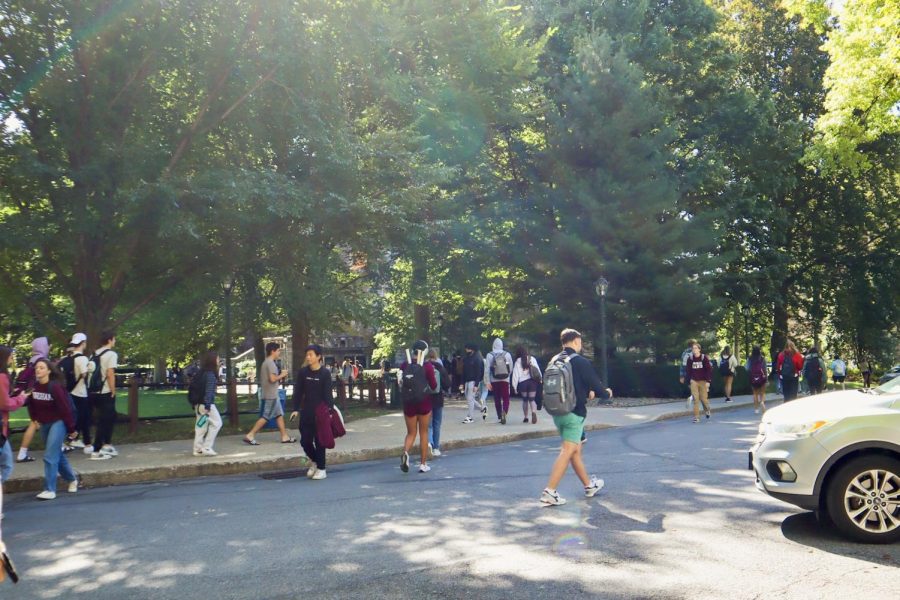Fordham Class of 2025 and 2026 are Largest in Fordham History
The classes of 2025 and 2026 are the largest classes to ever come to Fordham. Due to the combined sizes of both classes, some new procedures have had to be taken to accommodate them on campus.
Many first-year and sophomore students take primarily core-level classes. According to Maura Mast, dean of Fordham College Rose Hill, the university had to add new faculty to teach these classes last year.
“In fall 2021, we definitely needed to add more sections of core courses and, therefore, had to hire more faculty. We also increased course caps for some courses, because room availability at peak times is really limited. For fall 2022, we didn’t need to add too many additional sections,” said Mast.
Individual departments have different procedures for hiring staff. According to Mast, the same had to request more faculty in the spring of 2022.
“Departments and programs take multiple approaches to staff courses. It helped that last year, over 10 new, tenure-track faculty were hired in Arts and Sciences. In spring 2022, departments made requests for additional lecturers in order to fully support the courses that we need to offer,” said Mast. “The Office of the Dean of Faculty of Arts and Sciences manages this process, in consultation with the deans of FCRH and FCLC. Departments and programs also hire adjunct faculty, depending on availability and needs. In some departments, graduate students teach.”
However, it is important to note that enrollment is low in the class of 2024. Because of that, it is easier to accommodate students in the classes of 2025 and 2026.
“The class that entered in fall 2021 was quite large, but on the other hand the class that entered in fall 2020 was quite small. We look at the size of the entering class but we also look at the overall size of the student body in each college,” said Mast. “In fall 2021, the total number of credit-bearing students enrolled in FCRH was 3,965. This is more than the total enrollment for fall 2020, which was 3,815, but lower than the total enrollment in fall 2018 and fall 2017.”
Housing is another area that had to adapt to the larger class sizes. Fordham University guarantees housing to students for all four years of their undergraduate education. Guaranteed housing and COVID-19 isolation housing accommodations can make housing difficult. One unique complication that faced the class of 2026 was accommodating students in on-campus housing at Lincoln Center. According to Charles Clency, director of residential life, about a dozen Lincoln Center students were “temporarily placed” at Rose Hill. Clency said all those students have been relocated to Lincoln Center or “scheduled to be assigned as soon as possible.”
Last year to accommodate the class of 2025, Tierney Hall was converted from a sophomore to a first-year residence hall. According to Clency, it has not entirely reverted to a sophomore year dorm.
“For the class of 2026, we used two floors of Tierney and some converted triples to assign this class — though it was not as large as the class of 2025 when they entered,” said Clency. According to Clency, the class of 2026 currently has 28 converted triples.
“Typically, Alumni Court South and Loschert have more converted spaces as the individual rooms are larger, and Loyola has several rooms that are already designed to be triples,” said Clency.
In a statement to the Ram, Christopher Rodgers, dean of students, spoke to how classes of these sizes can be sustained: “Fordham is blessed with one of those fortunate problems — an extraordinary number of students want to join our community. Each year — even through the uncertain environment of the ongoing health emergency — we work with colleagues to manage the number of admitted students guaranteed housing, an important tradition at Fordham. Tremendous credit for this effort goes to our housing operations staff in Residential Life — they are miracle workers, even searching residence halls for new places for students who need an assignment. We will be adjusting our approaches in the coming cycles to insure that our spaces in housing, services, and other necessities match rising demand. Looking ahead and through careful strategic planning, additional housing will be important for us to consider.”
The combined sizes of the class of 2025 and 2026 have created some changes within the university. When it comes to housing, Clency encourages students to reach out with questions or concerns.
“We encourage all students to seek out assistance whenever they may have questions or concerns. Residential Life is equally invested in our residents having a good experience living in the residence halls,” said Clency.
Looking to the future, if the class of 2027 is similar in size to the class of 2025 and 2026, changes will have to be made.

Isabel Danzis is a senior from Bethesda, Md. She is double majoring in journalism and digital technologies and emerging media. The Ram has been a very...











































































































































































































